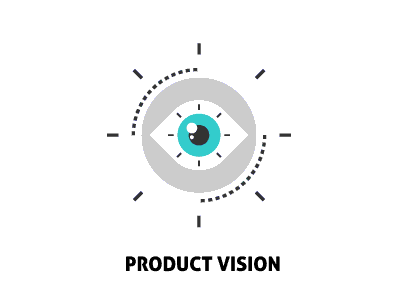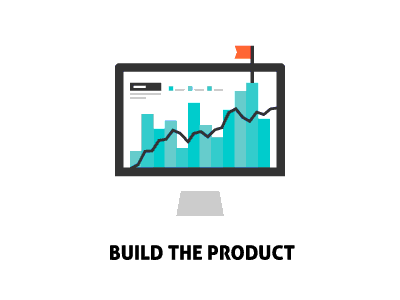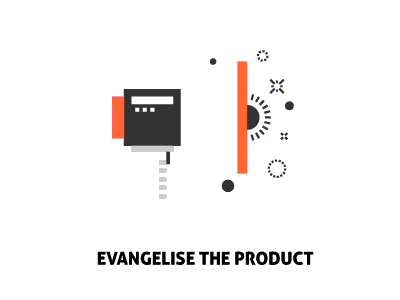Product managers have a very broad remit: to "build a winning product and business model that customers love." This raises the questions, "What kind of responsibilities does this entail?" and "What kinds of tasks does the product manager handle daily, weekly, and/or monthly to achieve this?"
The product manager is responsible for:
Defining a product vision
Developing this product vision into a winning product
Evangelising the product management role and their product in particular
Let's take a deeper look at these responsibilities.
1. Define a product vision

Doing product research: There are many sources of inspiration when it comes to deciding which problems to solve and which solutions to adopt. In order to decide which product or feature to build, the product manager must conduct research in order to be knowledgeable about:
Their competitors - the strengths and weaknesses of their product offerings and business model
Their customers - doing interviews with customers, watching them use the product in their natural environment and watching them use the product in person. A good product manager has empathy and can dig into customers motivations (i.e., not just what they say)
Their current product - observing the metrics of their current products to determine which features are popular. When metrics show that something is underperforming (e.g. not being used), it is the product manager who has to figure out why.
Their business model - a product is one part of a business model. Whatever business model exists or is being proposed, the product manager must identify the riskiest parts of the plan and all assumptions so they can be validated.
Defining a product vision: The product manager uses the information above to choose a problem to solve and tries to come up with a solution that has unique benefits compared to the competition.
Ideally, the product manager understands technology well enough to work with the tech team to identify to a feasible solution that can be built to solve this problem.
The product manager does not need the coding skills to build the product themselves, but they must work with the engineering and design resources to come up with a feasible solution.
2. Turn the product vision into a winning product

Groom a backlog of feature requirements: Once the team is on board with the product vision, the product manager now has to work with the engineering team to build the product. A fundamental part of building a product is creating a list of features that the product will need. This list of future features items is called a backlog. The product manager will get requests from many departments to improve the product (marketing, sales, legal, customer support, international markets) and they will have to keep a list of their day-to-day requests, as well as the features that they will need to fulfil the product vision.
Write specifications: the tech team will need to know which features need to be built, so the product manager will supply these specifications.
Work with the team: As the product is being built, the engineers, designers, and testers on the team will need the product manager's input. If there are any major questions that come up while the product is being built, it is the PM's responsibility to answer those questions. There will be times when features take longer than estimated to be completed, so the product manager will have to decide whether to reduce scope slightly or push out the planned release date. If the team needs other teams to supply necessary materials in order to deliver on time, the product manager must influence these teams to deliver what is required.
Define "done": Because the product manager is writing feature specifications, they will test completed features to check these specifications have been implemented correctly and give feedback to the team. Good teams usually have a checklist for what must be in place before features can be released. This checklist determines when a feature is "done" and ready for release.
Define a roadmap: As many individuals and teams in the organization will be making requests and suggestions for the product features, you need to have a clearly defined roadmap that shows them the plan of when these features will be released. Marketing and sales teams need to know about the release dates of future dates to co-ordinate marketing and sales activities.
Managing the project: It is important for the product manager to be available for the team during their daily meetings and weekly planning (or sprint-planning if the team is doing agile development) and to organize demos, monitor progress, and monitor the metrics of recently reviewed features.
As the team builds the product, there are thousands of micro-decisions that must be made. At times, the product manager will want to walk through some of these with the team to get their thoughts and at times, the product manager will make a decision on their own.
3. Evangelise the product

Managing the release: when it comes time to plan a major release, you will need to coordinate the release schedule in advance with other members of the organization- particularly the sales and marketing teams. Their ability to be effective will depend on assistance from you as the product is updated. Sales and Marketing teams should be excited and inspired to see new product improvements and innovations.
Promoting product management as a function: even today, many people have a hazy idea of what a product manager is, or they may only partially understand or even misunderstand the role. By clearly explaining what a product manager's role is and the value that it adds to the organization, the product manager creates an environment where co-workers are excited to work together to achieve the outcome. Product managers must be willing to have this conversation many times so that product management is truly embedded in the organization.
Promoting your product to everyone in the organization: As an organization can have many products functioning in many different countries, it is important that you promote your product internally by giving demos and continually up-selling the benefits and the success of your product. You are happy to talk about your product in any place at any time so that there is general awareness and appreciation of your product.
A typical day
One of the most enjoyable aspects of being a product manager is the truly diverse nature of the job - even within a single working day!
A typical day might look something like this:
9-10h Attend 15-minute daily standup meetings with different teams
10-11h Write requirements for upcoming feature
11-12 h. Meet with designer to discuss UX
12-13h Meet with head of marketing to discuss upcoming release
13-14h Lunch
14-16h Lead planning workshop with tech team
16-17h Conduct customer interviews
17-18h Test a completed feature
18-19h Meet with the EU Head of Sales to discuss upcoming feature requirements
As you can see, the product manager's responsibilities are truly varied - even within the same working day!
